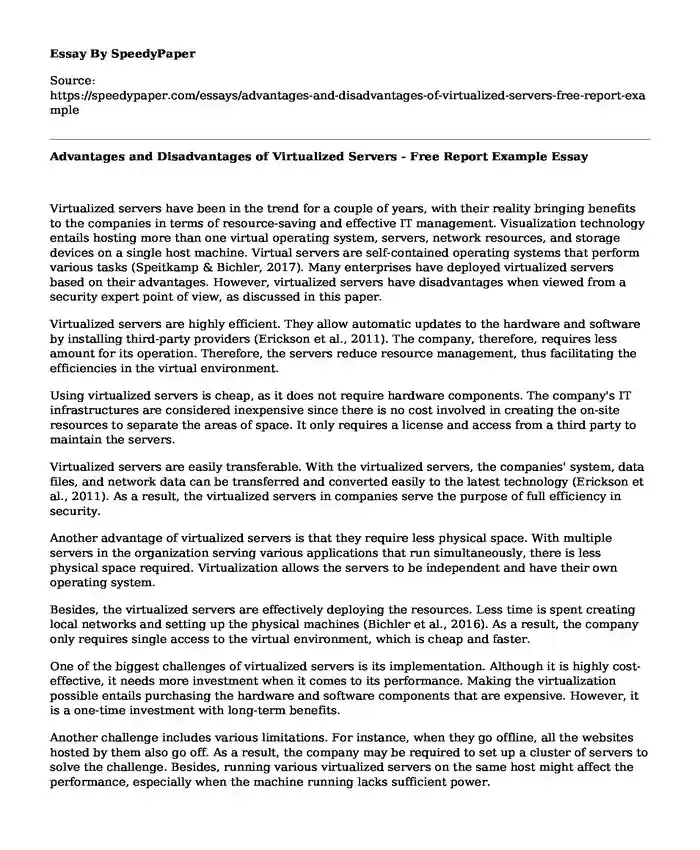
| Essay type: | Analytical essays |
| Categories: | Management Environment Technology |
| Pages: | 3 |
| Wordcount: | 628 words |
Virtualized servers have been in the trend for a couple of years, with their reality bringing benefits to the companies in terms of resource-saving and effective IT management. Visualization technology entails hosting more than one virtual operating system, servers, network resources, and storage devices on a single host machine. Virtual servers are self-contained operating systems that perform various tasks (Speitkamp & Bichler, 2017). Many enterprises have deployed virtualized servers based on their advantages. However, virtualized servers have disadvantages when viewed from a security expert point of view, as discussed in this paper.
Virtualized servers are highly efficient. They allow automatic updates to the hardware and software by installing third-party providers (Erickson et al., 2011). The company, therefore, requires less amount for its operation. Therefore, the servers reduce resource management, thus facilitating the efficiencies in the virtual environment.
Using virtualized servers is cheap, as it does not require hardware components. The company's IT infrastructures are considered inexpensive since there is no cost involved in creating the on-site resources to separate the areas of space. It only requires a license and access from a third party to maintain the servers.
Virtualized servers are easily transferable. With the virtualized servers, the companies' system, data files, and network data can be transferred and converted easily to the latest technology (Erickson et al., 2011). As a result, the virtualized servers in companies serve the purpose of full efficiency in security.
Another advantage of virtualized servers is that they require less physical space. With multiple servers in the organization serving various applications that run simultaneously, there is less physical space required. Virtualization allows the servers to be independent and have their own operating system.
Besides, the virtualized servers are effectively deploying the resources. Less time is spent creating local networks and setting up the physical machines (Bichler et al., 2016). As a result, the company only requires single access to the virtual environment, which is cheap and faster.
One of the biggest challenges of virtualized servers is its implementation. Although it is highly cost-effective, it needs more investment when it comes to its performance. Making the virtualization possible entails purchasing the hardware and software components that are expensive. However, it is a one-time investment with long-term benefits.
Another challenge includes various limitations. For instance, when they go offline, all the websites hosted by them also go off. As a result, the company may be required to set up a cluster of servers to solve the challenge. Besides, running various virtualized servers on the same host might affect the performance, especially when the machine running lacks sufficient power.
Management of the virtualized servers is another challenge. The virtual environments need to be instantiated, thus the need to create instances on virtual machines (Bichler et al., 2016). Managing virtual servers entails effective monitoring, configuring, and saving, which is also a challenge in management.
The servers are slow and take a lot of time. Dividing the server into multiple virtual servers might compromise efficiency. The network might become sluggish, making the server take a lot of time to process and operate.
Conclusion
Indeed, virtual servers offer more benefits as they help solve and facilitate several operations. Evaluating all the aspects of virtualized servers to avoid the various crises in terms of security in the companies.
References
Bichler, M., Setzer, T., & Speitkamp, B. (2016). Capacity planning for virtualized servers. 16th Workshop on Information Technologies and Systems, WITS 2006.
Erickson, D., Heller, B., Yang, S., Chu, J., Ellithorpe, J., Whyte, S., Stuart, S., McKeown, N., Parulkar, G., & Rosenblum, M. (2011). Optimizing a virtualized data center. ACM SIGCOMM Computer Communication Review, 41(4), 478–479. https://doi.org/10.1145/2043164.2018530
Speitkamp, B., & Bichler, M. (2017). A mathematical programming approach for server consolidation problems in virtualized data centers. IEEE Transactions on Services Computing. https://doi.org/10.1109/TSC.2010.25
Cite this page
Advantages and Disadvantages of Virtualized Servers - Free Report Example. (2024, Jan 05). Retrieved from https://speedypaper.net/essays/advantages-and-disadvantages-of-virtualized-servers-free-report-example
Request Removal
If you are the original author of this essay and no longer wish to have it published on the SpeedyPaper website, please click below to request its removal:
- Network Protocols - Computer Science Essay Example
- Essay Sample on the Advancement in Information Technology
- Management Project Proposal Template, Free Essay Sample
- Managing Conflict in the Workplace, Free Essay from Our Database
- Essay Sample on How Internet Use Influence People's Lives, Work, and Study
- Essay Sample on Rewards, Benefits & Compensation: Ethical Behavior and Leadership
- Developing Technologies for Enhancing Ethical Procurement in Supply Chains - Paper Example
Popular categories




